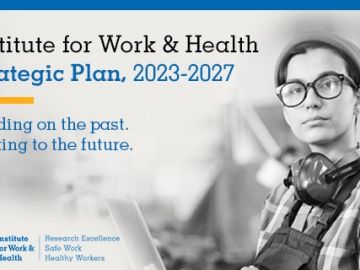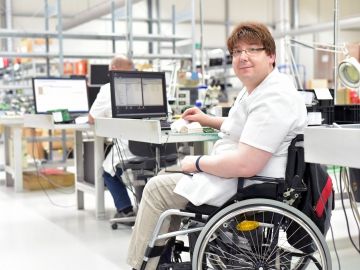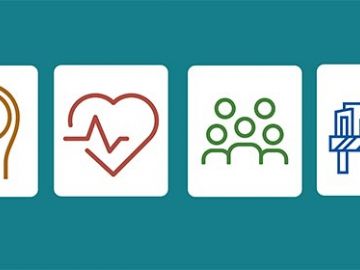What's new

We’re hiring a Director, Strategic Relations (maternity leave)
IWH is looking for a Director, Strategic Relations to cover a 13-month maternity leave beginning mid-September. This individual will work with IWH’s Executive, KTE and Communications teams diversify and expand IWH’s research and stakeholder networks and impact. They will also identify opportunities for IWH expertise to contribute to the development of policies, programs and resources at the provincial and federal levels—particularly within Ontario’s prevention system.
News release: Cannabis use outside of work hours not associated with increased risk of work injury, study finds
July 31, 2023 (Toronto, Ont.)—Are workers who use cannabis at greater risk of having an injury at work? Yes, but only those workers who use cannabis during or before a work shift. Workers who only use cannabis outside of work hours are at no greater risk of getting injured at work than workers who do not use cannabis at all.

What racial, ethnic inequities exist in return to work?
In the first systematic review on the subject, the Institute for Work & Health (IWH) examined the research literature on racial and ethnic inequities in return to work. It found strong evidence that non-white workers are less likely than white workers to return to work following an injury or illness—and moderate evidence that Black workers face pronounced barriers.

Role of IWH research in changes to B.C. legislation on claim suppression
After an IWH study filled a research gap on claim suppression in B.C. and helped make the case for change, the province amended legislation to strengthen protections against the practice.

IWH associate scientists promoted to scientists
Two IWH associate scientists were promoted to scientists effective July 1, 2023. Dr. Avi Biswas and Dr. Nancy Carnide received their promotion after two members of the Institute’s Scientific Advisory Committee reviewed dossiers outlining their research activities as associate scientists, as well as their future plans as IWH scientists. In each case the recommendation to promote was unanimously positive.

IWH study finds associations between workers' physical activity patterns and cardiometabolic health
According to an IWH study, Canadian workers typically fall into six patterns of daily movement that are associated with varying levels of cardiometabolic disease risk. In general, workers with higher daily activity levels had lower levels of cardiometabolic disease risk factors, but those with moderate activity levels also showed lower risk factors.

What research can do: Tell us your stories about using IWH research
Have you used IWH research, shared it with colleagues, endorsed it to your network, or referenced it in your communication materials? We want to hear from you! We love hearing about and profiling stories of how IWH research has helped our stakeholders and partners. Your stories will help us assess the impact of our work and improve its usefulness to you.

New social innovation lab launched to build employer disability confidence
A new social innovation lab, called Inclusive Design for Employment Access (IDEA), has hit the ground running. It’s now looking for partners across Canada and across all sectors to identify, develop, pilot and scale up innovative solutions to overcome labour-market barriers for persons with disabilities. IDEA aims to skill up workplaces so that they are confident in their ability to provide meaningful employment for persons with disabilities.

IWH’s new strategic plan aims to strengthen work and health research in an ever-changing society
Building on the past, looking to the future. This is the basis of the Institute for Work & Health (IWH)’s new five-year strategic plan, in which IWH sets out its goals to use the research expertise and partnerships it has built over the past 30 years to address complex work and health challenges.

Imagining the future of work for young adults with disability
What will work look like in 2030 for young adults living with disability? Using established strategic foresight methods, an IWH team generated three future scenarios. The scenarios are designed to provoke discussions in Canada about the policies and programs needed now to ensure inclusive work in the future for persons with disabilities.

The Institute for Work & Health releases 5-year strategic plan
The Institute for Work & Health (IWH) has released its 2023-2027 Strategic Plan, which outlines four strategic directions that will guide the Institute in producing and sharing work and health evidence. This plan is the result of a year-long process that engaged stakeholders, members of the IWH Board of Directors and staff to take stock of IWH’s strengths and identify opportunities and priorities for the next five-year period.

New study examines the job quality of persons with disabilities
Persons with disabilities are not only less likely than those without disabilities to find work. When they do, they are also twice as likely to find themselves in insecure, unrewarding jobs. This was a key finding from a recent IWH study that used a national survey to investigate what kinds of jobs persons with disabilities obtain compared to those without disabilities.

Marking Day of Mourning
Every year, on April 28, we mark National Day of Mourning to remember those who have died or suffered health consequences due to work hazards. On this day, especially, we renew our efforts to make work safe and healthy for all.

Sign up now: Inclusive Design for Employment Access (IDEA) launch event
On Thursday, May 18, the Inclusive Design for Employment Access (IDEA) social innovation laboratory is hosting a launch event. This partnered, knowledge-to-practice initiative is focused on building employers’ capacity to hire, promote and retain persons with disabilities, and to create accessible and inclusive workplaces.

2023-2024 Syme Research Training Awards now accepting applications
Calling early-career researchers at the master’s or doctoral level intending to study work and health: apply now for a 2023-2024 S. Leonard Syme Research Training Award. Three training awards of $5,000 each are available. The deadline for applications is Friday, May 5, 2023.

Now available: a tool to help workers with chronic conditions find job-tailored supports
The IWH-led Accommodating and Communicating about Episodic Disabilities partnership has officially launched the Job Demands and Accommodation Planning Tool (JDAPT) for workers. The evidence-based tool is designed to help workers with chronic conditions identify job supports that they can implement — on their own or with their supervisor’s approval — that allow them to keep working safely and productively without having to disclose their health condition.

What might the future working world look like for young adults with disabilities?
An IWH research team has examined how working life could change in Canada over the next seven years and what the implications might be for young adults with a disability. Using strategic foresight methods, the team created three future scenarios that are designed to provoke discussion about the policies needed now to ensure an inclusive future for people with disabilities.

IWH unveiling tool to help workers with chronic conditions find job-tailored supports
An evidence-based tool from the Institute for Work & Health (IWH) helps workers with chronic conditions learn about customized job supports and modifications that can help them continue to work safely, comfortably and productively. On March 21 at an IWH Speaker Series webinar, Senior Scientist Dr. Monique Gignac unveils the new Job Demands and Accommodation Planning Tool (JDAPT) developed by the Accommodating and Communicating about Episodic Disabilities (ACED) partnership. She describes the tool, how it works and the studies conducted to back it up.

The Winter issue of At Work is out!
In the issue, read about:
- A new research program on AI, work and health
- IWH's OHS Vulnerability Measure's high ranking in a study of leading indicators
- The inclusion of the 'Seven Principles' in Workers Compensation Board of Manitoba's updated return-to-work workshop
And more...

New study looks at mental health and earnings of U.S. young adults over 20-year span
A study based on a large, nationally representative sample of 8,000 individuals in the U.S. looked at their earnings and mental health over 20 years. It found those with poor mental health are also the ones with the lowest earnings.

What research can do: Manitoba’s WCB uses IWH research in update of RTW workshop
The Workers Compensation Board of Manitoba recently updated its Return to Work Basics workshop, and the Institute’s ‘Seven Principles for Successful Return to Work’ is a key part of it. In our latest impact case study, summarized here, Manitoba WCB’s return-to-work manager shares her thoughts on the value of research.

IWH’s OHS Vulnerability Measure leads pack in study of leading indicator tools
In an Australian study of five occupational health and safety (OHS) leading indicator tools around the world, a measure developed by the Institute has come out ahead for its ability to pick up workers’ risk of reporting a physical injury or a near-miss at work. The OHS Vulnerability Measure is now one of two tools recommended by the study team for use by the local workers’ compensation authority.

IWH Speaker Series: Findings from systematic review on racial and ethnic inequities in RTW
Studies to date have found evidence of racial inequities in work-related injuries and illnesses, but what about in return to work (RTW)? On January 17, in the first IWH Speaker Series presentation of 2023, an IWH team shares findings from a systematic review on racial inequities in the reintegration of injured or ill workers. The team will also discuss opportunities to address obstacles faced by workers of colour in RTW and provide recommendations for future research.

Twenty-year look-back by former IWH president finds bright spots in prevention system
On November 3, the Alf Nachemson Memorial Lecture returned after a three-year hiatus with a look-back by Dr. Cameron Mustard. The former IWH president shared five key learnings gleaned over his 20 years at the helm of the Institute.

Our KTE team is hiring!
Join the team that’s charged with getting IWH research out to users and stakeholders. Check out our opportunities page for details on two full-time, permanent postings: one for Knowledge Transfer & Exchange (KTE) Associate and one for Visual-Digital Communications Associate. The deadline to apply is December 22.

IWH launches research program on AI and workplace safety, inequities
Uses of artificial intelligence (AI) are all around us but, until now, few researchers have examined the impact of AI through the lens of worker inequities and worker health and safety. In October, a team led by IWH Scientist Dr. Arif Jetha kicked off a new research program at IWH on these topics.

IWH Speaker Series: Effectiveness of mandatory training standard to prevent falls from heights
In 2015, the Ontario government implemented a working-at-heights (WAH) training standard to ramp up fall prevention efforts. An IWH study team, led by IWH Scientist Dr. Lynda Robson, has now gathered two additional years of data on the effectiveness of this training requirement. Find out what the team learned at our next IWH Speaker Series webinar, taking place on December 13.

Employers struggle to provide newcomers with OHS training and support, IWH study finds
Employers are responsible for providing occupational health and safety (OHS) training and support to keep workers safe. When it comes to workers who are new to Canada, however, workplaces face particular challenges following through on this responsibility.

IWH Updates - Fall 2022
IWH thanks former Board of Director members and welcomes new ones ~ IWH’s latest annual report highlights research on both emerging and longstanding issues